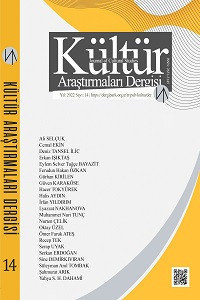Agatha Christie'nin "Bağdat’a Geldiler" Adlı Romanında Duygulanım, Uzamsal Bağlantılar ve Kentsel Uzam
Agatha Christie’nin casusluk hikâyelerine örnek teşkil eden Bağdat’a Geldiler (1951) adlı romanı, Soğuk Savaş döneminin ilk safhalarında, uluslararası diplomatik çatışmalara ve Irak petrol rezervleri üzerindeki gizli savaşa da ışık tutan siyasi bir arka plana sahip olmakla birlikte türsel açıdan bir gerilim hikâyesi olarak da ele alınabilir. Romanın sahneleri, casus kovalamacalarından Orta Doğu’daki arkeolojik kazı alanlarına, gülünç bir aşk hikâyesinden cinayet öyküsüne beklenmedik bir hızla geçiş yapmakta, Christie’nin alışılageldik dedektif öykülerinden farklılaşmaktadır. Agatha Christie’nin romanları türsel açıdan çeşitli çalışmalara konu olmuştur ancak, bu çalışma, söz konusu romana türsel ve biçemsel açıdan incelemek yerine, uzam kuramlarını kullanarak Orta Doğu’nun konumlandırılışını incelemeyi hedeflemektedir. Öykünün uzamı, hikâyenin ana kahramanı Victoria Jones’un kültürel ve toplumsal sınırları aşmasına imkân sağlamakla birlikte, Bağdat’ta konuşlanan uluslararası güç odaklarının planlarını aydınlatma konusunda imkan sağlamaktadır. Bu çalışma, Nigel Thrift’in şehir, birey ve duygulanım arasındaki ilişkiye dikkat çektiği çalışmalarına dayanarak, Bağdat’ı “akışkan bir şehir” olarak incelemekte, romanın türsel özellikleriyle de örtüşen korku, kuşku, kaygı, güvenlik ihtiyacı, yer-yön kaybı gibi uzam (space) ve beden (corporeality) arasındaki duygulanımsal bağları (affective relations) incelemeyi hedeflemektedir.
Anahtar Kelimeler:
Agatha Christie, Duygulanım, Uzamsal Duygulanım, Kentsel Mekan, Bağdat
Affect, Spatial Practices, and the City in Agatha Christie's "They Came to Baghdad"
They Came to Baghdad (1951), one of Agatha Christie’s mid-career books, could be categorized as a political thriller that unravels the ideological conflicts during the early Cold War period and the fight over Iraqi oil reserves. The scenes of the novel, like an adventure movie alters from a spy hunt to an archaeological theme, then to a romance, and finally a murder story and a thriller, in which fear comes up unexpectedly. Particularly, the setting provides the grounds for the female protagonist of the novel, Victoria Jones, to cross cultural and social boundaries and explore the space as a naïve pseudo-spy working for the international forces in Baghdad. By the lens of Nigel Thrift’s concept of “affective cities” and “spatialities of feeling,” this paper aims to explore how the setting of the novel—Baghdad—creates an intensive field of conflicting cultural and social forces that inscribe the female body, which runs in parallel with the narrative tactics Christie uses in revealing the affective emplacements of fear, suspicion, increasing levels of anxiety and insecurity in the cityscape. This paper, in other words, offers a spatial analysis of the novel in order to explore how the cityscape is mobilized and altered by the shifting perceptions of it by Victoria Jones while she defies the patriarchal demarcations of space. Through her adventures, it becomes possible to comprehend how power is distributed and circulated within this Middle Eastern society.
Keywords:
Affect, spatialities of feeling, Agatha Christie, Baghdad, Urban Space,
___
- Altieri, Charles (2003). The Particulars of Rapture: An Aesthetic of the Affects. Ithaca and London: Cornell University Press.
- Amin, Ash, and Thrift, Nigel (2017). Seeing like a City. Cambridge and Malden: Polity.
- Boltanski, Luc (2014). Mysteries and Conspiracies: Detective Stories, Spy Novels and the Making of Modern Societies. Cambridge & Malden: Polity Press.
- Bunson, Matthew (2000). The Complete Christie: An Agatha Christie Encyclopaedia. New York: Pocket Books.
- Christie, Agatha (2011). They Came to Baghdad. New York and London: Harper.
- de Certeau, Michel (1984). The Practice of Everyday Life. Berkeley: University of California Press.
- de Certeau, Michel (1987). “Practices of Space”. On Signs. (Ed. Marshall Blonsky). Oxford: Blackwell, 122-45.
- Deleuze, Gilles and Guattari, Félix (2005). A Thousand Plateaus: Capitalism and Schizophrenia. (Trans. Brian Massumi). Minneapolis and London: University of Minnesota Press.
- Grosz, Elizabeth (1995). Space, Time and Perversion: Essays on the Politics of Bodies. London and New York: Routledge.
- Kipling, Rudyard (2013). 100 Poems: Old and New. Cambridge: Cambridge University Press.
- Massey, Doreen (1994). Space, Place, Gender. Minneapolis and London: University of Minnesota Press.
- Metcalfe, Andrew and Ferguson, Lucinda (2001). “Half-Opened Being”. Timespace: Geographies of Temporality. (Eds. Jon May and Nigel Thrift). London and New York: Routledge, 240-61.
- Pleßke, Nora (2014). The Intelligible Metropolis: Urban Mentality in Contemporary London Novels. Bielefeld: Transcript.
- Seed, David (2003). “Spy Fiction.” The Cambridge Companion to Crime Fiction. (Ed. Martin Priestman) Cambridge: Cambridge University Press, 115-134.
- Soja, Edward (2003). “Writing the city spatially”. City, 7 (3): 269–280.
- Thrift, Nigel (2008). Non-Representational Theory: Space, Politics, Affect. London and New York: Routledge.
- Wang, Ming-Fong (2012). “Risk Society and Nation State: Agatha Christie’s Espionage Novels.” Intergrams: Studies in Languages and Literatures. 122-131.
- ISSN: 2651-3145
- Yayın Aralığı: Yılda 4 Sayı
- Başlangıç: 2018
- Yayıncı: Mehmet Ali YOLCU
Sayıdaki Diğer Makaleler
Sosyal Medya Salgını: Türkiye'de Korona'nın Mizahi Yönü
Kamusal Mekanın Göstergebilim Bağlamında İncelenmesi: İstanbul Eyüp Sultan Meydanı
Kültürel Bellekten Elektronik Ortama: Kültür Aktörlerinin Yeni Varlık Alanı Olarak Hazır Mesajlar
Velayetname ve Halk Anlatmalarından Hareketle Güvenç Abdal'ın Sosyal Rolleri
Klasik Dönem Polonya'da Katolikliğin İnşasına Sosyolojik Bir Yaklaşım
Kayseri Aşıklık Geleneğinde Aşık Mazlum Berrakî
Türkmen'in Ünlü Şairlerinden Seydî'nin Şiirleri
